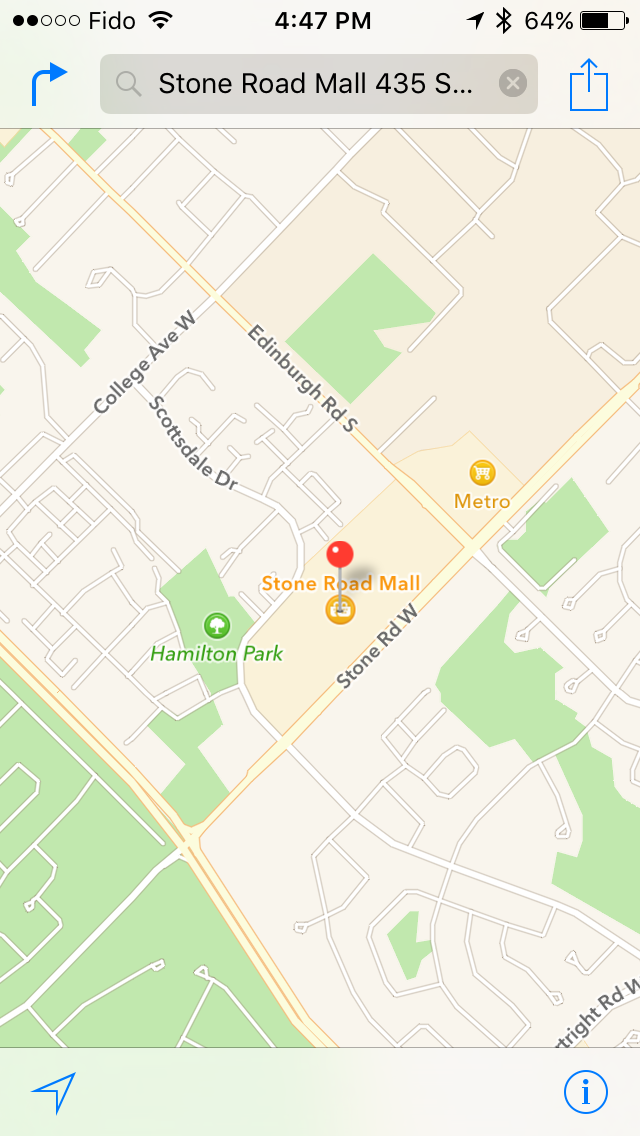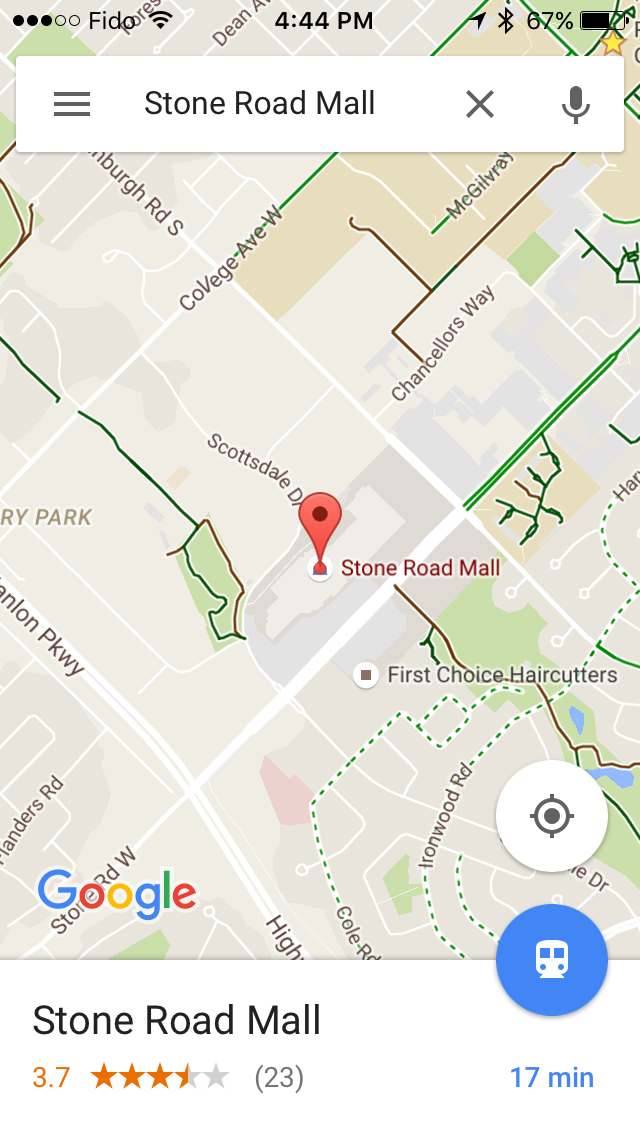The Apple iOS 9 Review
by Brandon Chester on September 16, 2015 8:00 AM EST- Posted in
- Smartphones
- Apple
- Mobile
- Tablets
- iOS 9
Apple Maps: Now With Transit
Apple Maps has been the butt of many jokes in the tech industry since its initial release with iOS 6. At that time it was clearly not ready to start shipping, and it paled in comparison to the previous maps app which used data from Google. Apple was forced to issue a public apology for the issues, and recommended that users use mapping services other than Apple Maps. Since that time, Apple has steadily improved their maps by acquiring companies, sending out cars to do manual mapping, and adding new sources of information for businesses. Even with their improvements, Apple Maps has still lagged behind Google Maps in some key areas, with one of them being built in directions for public transportation. With iOS 9 Apple has implemented their own transit directions right into the app, bringing back a feature that was lost with the switch from Google to their own mapping service three years ago.
Ever since the original Apple Maps release I have used Google Maps to find locations and get directions, as it provides the same experience on iOS and Android, and because public transit directions are something I need. With transit returning to maps on iOS, I thought it was worth going back to Apple Maps to see what improvements have been made in the last three years, and how it compares to Google Maps in my local area.
My first impression is that the Apple Maps application itself is better than Google Maps on any platform. Google Maps has always had fairly janky scrolling and zooming for me. Apple Maps definitely isn't devoid of stuttering, but it's normally significantly smoother than Google Maps. I find the aesthetics of the maps themselves to be nicer, and I think it's just due to the colors used and the fonts for the street names. The Apple Maps app also fits in better with iOS by following Apple's design and navigation guidelines, while Google Maps, like Google's other apps, feels like you're running an Android application and uses methods of navigation that are actively discouraged on iOS.
Google Maps certainly has a number of advantages though. I enjoy travelling by bike, and Google Maps has a really great overlay that shows you bike trails which are often submitted or edited based on user submissions. Apple Maps has no such thing, and I don't know how they would ever match the feature because it would require getting cyclists to submit to Apple Maps as well as Google, which will never occur to any meaningful extent. Google Maps also shows you the names of streets at a reasonable zoom level, while Apple Maps barely shows you any street names until you zoom so close that you don't even have a concept of where you are. The satellite imagery in Google Maps is also much better; it never turns to black and white like Apple Maps, and is noticeably higher in detail and resolution.
At the same time, Apple Maps has some advantages too. While it's very reluctant to put the names of streets, it lists many businesses and they all appear to be accurately placed. In contrast Google Maps does the same thing Apple Maps does with street names and makes only the ones it has arbitrarily chosen show up unless you zoom really close. If you're having to balance clutter I would probably choose to show street names rather than businesses though.
Both mapping apps actually had some issues with the accuracy of their mapping. Google Maps omits a ton of small streets that branch off of other streets, while Apple Maps marked a residential area as though it was a field. There are also some paths and roads that are marked in a questionable or incorrect manner in Apple Maps.
If I had to choose an application based solely on the quality and accuracy of the maps themselves, I would have to go with Google Maps. Apple Maps has improved greatly in my area since it originally launched, but Google has been in this business for far longer and they've collected and accurately marked a lot of data in that time. For my purposes Apple Maps is definitely sufficient, as I really treat my maps app more like a GPS device than a map, and so I was very interested to see what Apple has done with transit.
When Apple announced transit support at WWDC they did so in a somewhat confusing manner. It seemed that it would only support a handful of major cities, like New York, London, and Toronto. In reality, transit directions are supported in a great number of cities, and the ones specifically mentioned by Apple are the cities where they have created map overlays that show all the transit lines in the city. This is really not unlike the situation with Google Maps, where the cities that have transit overlays are big cities that have various types of public transport that run both above and below the ground. Clearly Google still has an advantage of scale, especially with Apple launching with few European and no Japanese cities, but these will be improved over time just like the maps themselves have been.
Of course, coming late to the party does give Apple a chance to think about what things could be done better about transit. For example, you can see above that when you select Toronto's Union Station in Apple Maps you're presented with a very clean view containing relevant info and sections for all the different transport services that run there. In contrast, Google's listing actually splits the station into five separate points on the map for the different transit services, and when you click on one the different transit lines are just laid out haphazardly.
The most amazing thing of all is that contrary to the reputation Apple Maps has, the transit directions and maps are accurate! Not only are they accurate, but I've seen several situations where they give a more sensible route than Google Maps has, and I even had to deal with this firsthand when travelling in Toronto earlier this year. Above you can see me trying to travel from Toronto's Union Station to High Park. Apple Maps presents a very logical route which takes the subway for the entire journey. For whatever reason, Google Maps suggests taking the subway for one section, and then taking a street car which results in a longer journey and also places you in a less convenient spot near a loud expressway on the other side of the park.
I've also noticed that in my city the algorithm Google Maps has used to map the journey of buses has made a number of errors. I see several cases where your route apparently takes you floating over a river, or through the middle of residential areas. While these may seem inconsequential, if the errors occur near the beginning end of your route it can be difficult to tell where you need to get or where you'll be let off. Google Maps also doesn't let you know when a route has been put on a detour due to construction, which is another way to end up missing the stop you want to get to. It really sounds crazy even to myself, but in my experiences I've seen Apple Maps constantly outperform Google Maps as a transit tool.
Now before anyone gets the wrong impression based on what I've written here, I want to reiterate that these are only my experiences. I can't travel too far to test out maps, and I live in a fairly urban area. I've heard and seen the stories of areas where Apple Maps is still mapped completely wrong, or where there's no map at all. I'm sure there are lots of stories that run contrary to my experience. However, with Apple Maps being used by 3.5x the number of users that Google Maps on iOS has, it's clear that a lot of users do find the default maps app to be satisfactory.
My big complaint now is that there are no bicycle routes, and that's an area where I predict Google will have a continued advantage. With that said, I think the better performance and better design of the Apple Maps app are serious points to consider as well. If you're someone who turned away from Apple Maps initially like I did I would encourage you to give it another try. If it's a disaster, then Google Maps is still there to provide great mapping info. However, I think the good aspects of Apple Maps may surprise you, as they surprised me.



















227 Comments
View All Comments
nafhan - Wednesday, September 16, 2015 - link
Wrong. iPads get used by professionals (in addition to "prosumers") all the time for content creation tasks while on the go like music recording, viewing tablature, reviewing photos with clients, etc. Just because the content creation isn't happening on the tablet doesn't mean it's not getting used as part of a content creation workflow.That said: they are not a professionals primary content creation device. They're a secondary device that gets used when it's not reasonable to use the primary device for some reason.
The Surface is going to fall into the same boat. Someone who does these types of content creation tasks is probably going to want something more powerful than Surface for their regular work. The iPad Pro and the Surface will both be used when the primary device is not available.
Also, you are absolutely correct in that the vast majority of iPads (and computers) sold are as consumption devices. That's why the iPad mini exists!
superflex - Wednesday, September 16, 2015 - link
Yikes.A koolaid fight has broken out and everyone is drunk on their brand of OS punch.
You clowns are worse the the GPU fanbois.
Makes reading the comments at AT a waste of time.
Now get back to your respective OS shrines.
lilmoe - Wednesday, September 16, 2015 - link
You're contradicting yourself;"Just because the content creation isn't happening on the tablet doesn't mean it's not getting used as part of a content creation workflow".
That was exactly my point, and the point you emphasized in your last paragraph. iPads (even the lateset "Pro") can never be used for standalone, real professional work. The iPad "Pro" might be good for simple sketching at best... I mean, the new "pencil" doesn't even support hover or palm rejection, nor does the "Pro" run any full blown professional programs.
There's nothing an iPad can do that a Surface can't (provided the mobile app is there). But the Surface can also replace laptops for many consumers, they can be the sole PCs of many prosumers, and they can be the mobile workstations of professionals because they can run the full blown programs their used to. Something iPads can never do.
Android was never a real threat to iPads. However, while Apple isn't worried about the Surface series in particular, the real threat to iPads lies in Windows 10 and Universal Windows Platform.
I can't wait for a Samsung made Wacom Windows 10 tablet with a Core M7.
nafhan - Wednesday, September 16, 2015 - link
I'm not contradicting myself.Your argument seems to be that since it could be used as an all around replacement for every computer, professionals are using the Surface that way. My observation is that you are wrong. People who make money doing creative work generally don't have an MS based workflow, at all, and that even if they did, they'd probably still only use the Surface as a primary computer when absolutely necessary. If you're making money at your job and doing creative work, you're going to want a more powerful computer with more storage than the Surface as your main computer.
I have a feeling that you have never worked with any professionals. They don't want Swiss Army knives. They want dedicated tools to get their work done easily and quickly. I'll sort of take that back: they do want the Swiss Army knife device, just as a secondary or tertiary device, not as a primary.
The-J-Man - Friday, September 18, 2015 - link
This is changing. Some creatives are moving to Windows-based workflows as there are shifts in the industry, and Surface Pro is significant part of that. Ever since the first Surface Pro came out, the question among creatives is "Can it run Photoshop?" (Yes, it can.) Since that day, I think most creatives realize that iPads are consumption only. If you can have a tablet that is a presentation device that also lets you do actual work on a train or at a coffee shop between meetings, then isn't that better, even if it doesn't have iMessage?Apple has had some missteps lately in the creative world. The garbage can look-alike Mac Pro is selling so poorly that I don't know anyone who owns one. Adobe's Premiere Pro takeover of Final Cut market share is significant and seems to be accelerating. It is getting harder and harder to justify the IT costs of supporting a department of Macs in an otherwise Windows environment, just to get the graphics work done. (Yes, Macs need support. They are not magic.) Most artists are getting used to using Windows through Boot Camp, and Windows 10 is actually a really nice experience.
You are right that it is fairly safe to assume a creative is working on a Mac these days, but devices like Surface Pro are very impressive, even to us creatives. iPad Pro, to me, looks like a Surface Pro without the ability to run any of the apps that I really want to run. Let's face it, Creative Cloud programs like Photoshop and After Effects are where the money is, not those silly ideation apps Adobe keeps trying to push.
Most creatives work on a workstation with a Wacom tablet and multiple monitors for maximum productivity. Given the creative's standard equipment of a primary workstation, a secondary tablet/laptop, and a smartphone, I am guessing a lot of creatives would choose Surface Pro over iPad (Pro or otherwise) as their secondary device.
robinthakur - Thursday, October 1, 2015 - link
Most proper creatives doing it as a job that I know still use Apple, mainly for historic reasons it has to be said (try getting creatives to change tooling!) and the fact that the Surface Pro 3 runs Photoshop avoids the question of how well it runs it. The pen accuracy and pressure sensitivity as well as the display scaling are significant issues which hobble the SP3 to some extent and mean that it can't be used as a dedicated tool. The pen is designed primarily for OneNote, after all.The great unknown is the software for the iPad Pro. If Appl ecan persuade Adobe to release versions of CC and Micrososft to release versions of Office which are compiled for it with pen compatibility, then I can see it doing very well as all the User interface problems of not having a precision input device or keyboard will be solved.
KoolAidMan1 - Wednesday, September 16, 2015 - link
A Macbook Pro is a much better laptop than the Surface and an iPad is a much better tablet. The value of the Surface is that it combines both. If you want to combine both devices while introducing compromises then its a good option. There's certainly something to be said for having fewer things.Sc0rp - Wednesday, September 30, 2015 - link
The pencil supports palm protection dude.Morawka - Wednesday, September 16, 2015 - link
they'll lose imessage and facetime.. they dont care about safari, and everyone can agree that itunes is garbage. you seriously cited itunes as a reason to stay apple? Simplistic device are great and all, but it severely limits how you can improve them 5-10 years down the road without inherently making them more complex (therefore losing the simplicity)they are made of metal and are nice looking. the ui looks like a candy shop. they are successful because the iphone is successful. you think it will stay this way for much longer tho? It remains to be seen, but odds are not in their favor.
apple is pushing everyone to apps, even website developers (by ad blocking). apple is a compartmentalized experience on each device. They created lots of devices that only do a few things (but do them well) and then hope you buy all of them so they make lots of money.
meanwhile competitors with complex systems which allow you to do much more with fewer devices, but has steeper learning curve. do you want to pack 3-4 devices that each do a couple of things good, or 1-2 devices that can do everything.
let the market decide over the next 10 years, but eventually people will wise up and spend less money and pack less gadgets
centhar - Thursday, September 17, 2015 - link
Apple users are the Pakleds of the computer world. "We can make it go, no intelligence is required"